IJCRR - 4(22), November, 2012
Pages: 185-190
Date of Publication: 24-Nov-2012
Print Article
Download XML Download PDF
INVESTIGATIONS ON DIESEL ENGINE FUELED WITH SESAME OIL METHYL ESTER BLEND USING IGNITION IMPROVER
Author: G.G. Srinivas, D. Jawaharlal, G. Sulochana
Category: Technology
Abstract:Biodiesel is a methyl or ethyl ester of fatty acids made from vegetable oils and animal fat. It can be used in diesel engines with very little or no engine modifications. In this present work the experimental investigations are carried out on the test engine operated with methyl esters of sesame oil and diesel blends and also by using ignition improver as an additive. Comparative measures of performance parameters, smoke opacity, unburned hydrocarbons (HC), carbon monoxide (CO), oxides of nitrogen (NOx) and carbon dioxide (CO2) emissions were calculated. In the initial stage the tests were conducted on the four stroke single cylinder water cooled direct injection diesel engine by using diesel at various loads and base line data was generated. In the second stage, tests were carried out using methyl esters of sesame oil with diesel blends at same operating parameters and compared with the base line data obtained earlier. Engine performance in terms of higher brake thermal efficiency and lower brake specific fuel consumption and lower emissions (HC, NOx) were observed for 20% sesame oil and 80% diesel and it is chosen as optimum blend. Then after for above optimum blend in the third stage the tests were conducted again on the engine to find out the performance and emission parameters by adding ignition improver DEE (Diethyl Ether) in the proportions of 0.5% and 1%. Finally the performance and emission parameters obtained by adding DEE were compared with the optimum blend and it has been observed that no change in BTH and further reduction in emissions like HC, smoke opacity, NOx are observed.
Keywords: bio diesel, BSFC, emissions, Sesame methyl esters
Full Text:
INTRODUCTION
In present days the utilization of diesel engines are more compared with petrol engines for domestic purposes because of their higher performance and low cost of fuel. Since the petroleum crises in 1970s has revived more and more interests in the use of vegetable oils as a substitute of fossil fuel. In diesel engines several alternative fuels can be used without any engine modifications to compensate the petroleum based fuel crises. N.R. Banapurmath et al [1] carried out investigations on diesel engine operated with methyl esters of Honge oil (HOME), Jatropha oil (JOME) and sesame oil (SOME) engine performance in terms of higher brake thermal efficiency and lower emissions (HC, CO, NOx) with sesame oil methyl ester operation was observed compared to methyl esters of Honge and Jatropha oil operation. M. Pugazhvadivu et al [2] used pongamia oil as an alternative fuel for diesel engine using ignition improver DEE. The engine NOx emissions were noted to be higher without using DEE for all the blends, the addition of DEE leads to reduction of NOx and smoke emissions at low and medium loads. Sehmus Altun et al [7] used a blend of 50% sesame oil and 50% diesel fuel as an alternative fuel in a direct injection diesel engine. The experimental results show that the engine power and torque of the mixture of sesame oil–diesel fuel are close to the values obtained from diesel fuel and the amounts of exhaust emissions are lower than those of diesel fuel. Considering the literature it is concluded that bio fuels can be used as alternate fuels by evaluating its properties and blending them with diesel in small proportions can improve performance parameters and reduce emissions without modifying the engine design, adding ignition improver like DEE to optimum blend leads to further reduction of emissions. The properties of DEE permit it to use as fuel additive for diesel engines because of its higher cetane value, volatility and latent heat of vaporization compared to diesel and also for its non corrosive nature and lower auto ignition temperature. In this present work the effect of adding DEE in the proportions of 0.5% and 1% (S20D79.5DEE0.5, S20D79DEE1) to the optimum blend (S20) is studied.
Preparation of sesame oil methyl ester
The formation of methyl esters by transesterification of vegetable oil requires raw Sesame oil, 15% of methanol and 5% of sodium hydroxide on mass basis. However, transesterification is an equilibrium reaction in which excess alcohol is required to drive the reaction very close to completion. The vegetable oil was chemically reacted with an alcohol in presence of a catalyst to produce methyl esters. Glycerol was produced as a by-product of transesterification reaction. The mixture was stirred continuously and then allowed to settle under gravity in a separating funnel. Two distinct layers form after gravity settling for 24 hours. The upper layer was of ester and lower layer was of glycerol. The lower layer was separated out. The methyl ester was then blended with diesel in various concentrations for preparing biodiesel blends to be used in diesel engine for conducting various engine tests.
Properties of the bio-diesel
The properties of sesame methyl ester were found in the fuels laboratory are shown in Table 1.
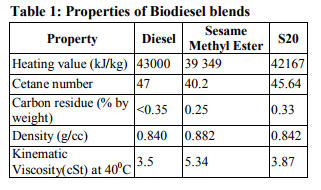
EXPERIMENTAL SETUP
The experimental set up shown in Figure 4.1 is a single cylinder, four-stroke, naturally aspirated, DI diesel engine. The set up is provided with necessary instruments like Rope brake dynamometer, Smoke meter (Netel’s-NPMDSM), Gas analyzer (Netel’s-NPM-MGA-2) etc., for performance and emission analysis. Specifications of test engine are shown in Table 2.
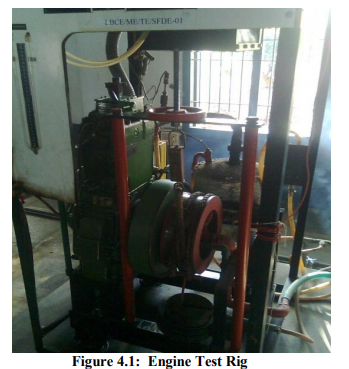
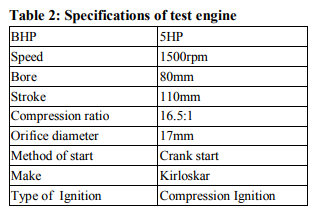
RESULTS AND DISCUSSION
The performance and emission characteristics of the test engine at various loads from no load to full load fuelled with sesame oil methyl ester using DEE compared with diesel, diesel with SME blend are discussed below as per the results obtained.
Specific Fuel Consumption
The BSFC obtained from calculations was plotted against brake power and compared the results for S20D79.5DEE0.5, S20D79DEE1, S20 and D100 are shown in Figure 1. From the plot it is observed that the BSFC’s for D100, S20, S20D79.5DEE0.5 and S20D79DEE1 blends at full load conditions are 0.26 Kg/KW-hr, 0.25 Kg/KW-hr, 0.25 Kg/KW-hr and 0.25 Kg/KW-hr respectively. As the percentage of DEE was increased, mass flow rate was not affected; considerable change in BSFC has not been observed for both the ignition improver blends compared to S20, D100. The BSFC of the engine slightly decreased because of better combustion due to the availability of excess oxygen in these blends.
Brake Thermal Efficiency
The brake thermal efficiencies which were obtained from calculations were plotted against brake power and compared the results for different blends as shown in Figure 2. From the plot it is observed that the BTH for D100, S20, S20D79.5DEE0.5 and S20D79DEE1 blends at full load conditions are 32.84%, 34.6%, 34.8% and 34.6% respectively. The reduction in viscosity because of increase in cylinder temperatures at maximum loads leads to better evaporation and mixing with air resulted in more complete fuel combustion caused the maximum thermal efficiency for SME blends and addition of DEE could not influence the BTH because of lower heating value of it.
Oxides of Nitrogen
NOx emissions are very important in polluted air. The most important factor for the emissions of NOx is the combustion temperature in the engine cylinder and the local stoichiometry of the mixture. The reduction of NOx emissions is possibly due to the smaller calorific value of the blends. Cetane number also plays significant role in reduction of NOx. Since DEE is a cetane improver and at highest concentration it improves the cetane number leads to reduction in NOx content and also high latent heat of vaporization of DEE causes lower temperatures inside the cylinder which in turn leads to reduction in NOx emissions in the exhaust gases. The variation of ppm of NOx with B.P for D100, S20, S20D79.5DEE0.5 and S20D79DEE1 blends are shown in Figure 3. There is no considerable change has been observed at full load when compared with S20 blend with S20D79.5DEE0.5, slight decrease has been observed at 75% load conditions because at higher loads high operating temperatures leads to increase of NOx. The NOx content reduced drastically with the blend S20D79DEE1 at full load conditions. It is observed that for D100 and S20 the NOx content is 1236ppm and 1040ppm and for S20D79DEE1 it is reduced to 990ppm means it is reduced by 20% compared with Diesel and by 4.8% compared to S20.
Smoke
The variation of smoke density with brake power test engine for D100, S20, S20D79.5DEE0.5 and S20D79DEE1 is shown in Figure 4. The smoke density of S20D79.5DEE0.5 compared to S20, D100 is reduced further more and there is no change with S20D79DEE1 when compared with S20. The oxygen enrichment contained by S20 and further addition of oxygen by DEE because of presence of oxygen in it, improves combustion which subsequently reduces the smoke density. The smoke densities at full load conditions using diesel and S20 blends are 79.6 HSU, 60 HSU and for S20D79.5DEE0.5 it is 53.5 HSU means it is reduced by 24.5% using S20 and 32.7% using S20D79.5DEE0.5 compared with diesel.
Carbon Monoxide
CO emission depends on many parameters such as air–fuel ratio and the engine temperature. It is one of the toxic products of combustion due to the improper burning of hydrocarbons (HC). The variation of CO with brake power of the engine for D100, S20, S20D79.5DEE0.5 and S20D79DEE1 are shown in Figure 5. From the plot it has been observed that the CO content for D100, S20, S20D79.5DEE0.5 and S20D79DEE1 blends at full load conditions are 0.08%, 0.08%, 0.1% and 0.1% respectively. There is slight increase has been observed by using DEE blends compared with S20 and D100.
Unburned Hydrocarbons
The variation of HC with brake power of the engine for D100 and S20, S20D79.5DEE0.5, S20D79DEE1 blends are shown in Figure 6. From the plot it has been observed that there is maximum decrease of unburned hydrocarbons taken place for both DEE blends. It has been observed that for D100, S20, S20D79.5DEE0.5 and S20D79DEE1 blends HC contents are 58ppm, 56ppm, 14ppm and 18ppm respectively means it is reduced by 75% and 69% when compared with D100 by S20D79.5DEE0.5 and S20D79DEE1 blends respectively. It is decreased by 75% using S20D79.5DEE0.5 compared to S20 and 68% using S20D79DEE1 compared to S20. The presence of oxygen and increased cetane number using ignition improver were caused to promote complete combustion.
Carbon Dioxide
Figure 7 shows the variation of CO2 percentage with brake power of the engine for D100 and S20, S20D79.5DEE0.5, S20D79DEE1 blends as 8.5%, 8.3%, 11.5%, and 11.3% respectively. It has been observed that slight increase in CO2 content occurred by using DEE blends. Furthermore content of O2 in these blends leads to convert more amount of CO into CO2.
CONCLUSIONS
Exhaust emissions of the sesame oil–diesel mixture were lower than that of using diesel and it can be used as an alternative fuel in view of reduced environmental pollution by reduction in HC, NOx emissions and also in increased brake thermal efficiency and also for decreased brake specific fuel consumption. By adding ignition improver DEE further reduction of HC, NOx emissions are experienced without effecting performance.

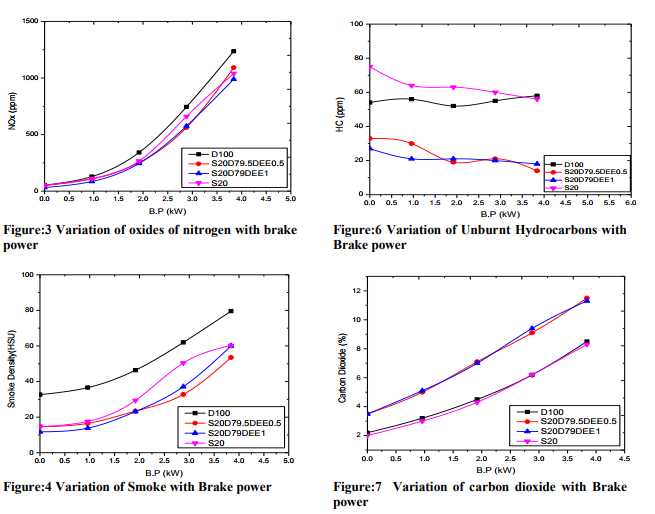
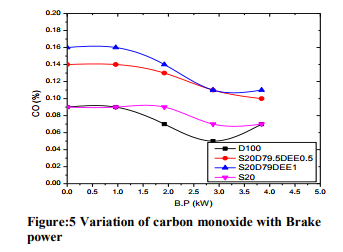
ACKNOWLEDGEMENT
The authors acknowledge the immense help received from the scholars whose articles are cited and included in references of this manuscript. The authors are also grateful to authors / editors / publishers of all those articles, journals and books from where the literature for this article has been reviewed and discussed.
References:
1. N.R.Banapurmath, P.G.Tewari, R.S.Hosmat “Performance and Emission Characteristics of A DI Compression Ignition Engine Operated on Honge, Jatropha and Sesame Oil Methyl Esters” Renewable Energy 33 (2008), pp.1982–1988.
2. M.Pugazhvadivu and G.Sankaranarayanan “Investigations on a Diesel Engine fuelled with biodiesel blends and diethyl ether as an additive”, Indian Journal of Science and Technology, Vol. 2 No. 5 (May2009), pp 31- 35.
3. Bello E.I and Makanju, “Production, Characterization and Evaluation of Castor oil Biodiesel as Alternative Fuel for Diesel Engines”, Journal of Emerging Trends in Engineering and Applied Sciences, 2011, pp 525-530.
4. Athanasios Balafoutis, Spyros Fountas, Athanasios Natsis and George Papadakis “Performance and Emissions of Sunflower, Rapeseed, and Cottonseed Oils as Fuels in an Agricultural Tractor Engine Athanasios” International Scholarly Research Network ISRN Renewable Energy, 2011, Article ID 531510, 12 pages.
5. Y.V.V.Satyanarayana Murthy, “Performance of Tobacco Oil-Based Bio-Diesel Fuel in A Single Cylinder Direct Injection Engine” International Journal of the Physical Sciences Vol. 5(13), 18 October, 2010, pp. 2066-2074.
6. Md. Nurun Nabi and S. M. Najmul Hoque “Biodiesel Production From Linseed Oil and Performance Study of a Diesel Engine With Diesel Bio-Diesel Fuels” Journal of Mechanical Engineering, vol. ME39, No.1, June 2008, pp.40-44.
7. S-ehmus Altun, Hu¨ samettin Bulut, Cengiz O¨ner “The Comparison of Engine Performance and Exhaust Emission Characteristics of Sesame Oil–Diesel Fuel Mixture with Diesel Fuel in a Direct Injection Diesel Engine”, Renewable Energy 33 (2008), pp1791–1795.
8. V.R. Sivakumar, V.Gunaraj, P.Rajendran “Statistical Analysis on The Performance of Engine With Jatropha Oil as an Alternate Fuel” International Journal of Engineering Science and Technology Vol. 2(12), 2010, pp.7740-7757.
9. K. Anbumani and Ajit Pal Singh. “Performance of Mustard and Neem Oil Blends with Diesel Fuel in C.I Engine” APRN journal of engineering and applied sciences, vol. 5, no. 4, April 2010, pp 14-20.
10. Niraj S. Topare, V.C. Renge, Satish V. Khedkar, Y.P. Chavan and S.L. Bhaga “Biodiesel From Algae Oil as an Alternative Fuel For Diesel Engine” International Journal of Chemical, Environmental and Pharmaceutical Research, Vol. 2, No.2-3, May-December-2011,pp 116-120.
11. M.Mani, C.Subash, G.Nagarajan “Performance, Emission and Combustion Characteristics of a DI Diesel Engine Using Waste Plastic Oil” Applied Thermal Engineering, volume 29, Issue 13, September 2009, Pages 2738-2744.
12. S.Jaichandar, K.Annamalai “The Status of Biodiesel as an Alternate Fuel for Diesel Engine – An Overview” Journal of Sustainable Energy and Environment 2(2011) Pages 71-75.
|






 This work is licensed under a Creative Commons Attribution-NonCommercial 4.0 International License
This work is licensed under a Creative Commons Attribution-NonCommercial 4.0 International License